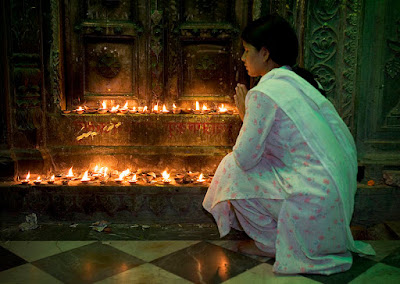Nataraja
"Risha! Come downstairs right now!"
"Mom, I'm finishing my game right now. I'll be down in a second," exclaimed Risha.
"Okay, Risha, tonight I want to tell you a quick story about Lord Shiva," Aarti informed her daughter.
"But, Mom, Raj isn't here...do we have to have story time without him?"
"Beta*, this story is more for you anyway. You will relate to it more than your brother."
After some bribing, Aarti was able to convince Risha to listen to the story of the Great God, Shiva.
"Okay, Risha, this story is important for you to hear because it has to do with your dance classes."
Risha has been doing Bharatanatyam, classical Indian dance, for almost three years.
"Did you know that every time you go to class and do your opening prayer dance, you are praying to Lord Shiva? Lord Shiva is known as the King of Dance. In this form, he is called Nataraja."
"Wait, are you talking about the copper statue we pray to before we start dancing?"
"Yes, Risha, that is Lord Shiva in the Nataraja form. In this form, he is known to be the universal dancer. Lord Shiva does his divine dance so he can destroy the worn out universe and get it ready for renewal."
"Wow, I didn't even think that I was praying to Lord Shiva when I did Bharatanatyam."
"See, beta, this is why I wanted to tell you. Can you tell me what the Nataraja statue looks like?"
"All I really remember is the color. The Nataraja is copper. Oh, also, Lord Shiva is doing a Bharatanatyam pose. One of his legs are up."
"Beta, the pose comes from the Nataraja. So, whenever you are dancing to a story about Lord Shiva, I am sure you will strike this pose at least once."
"Can you tell me what else is on the statue," asked Risha.
"Well, there are flames around Lord Shiva. This represents the universe. In the statue, he has 4 hands. In two of his hands, he is holding a small drum and a small flame. In one hand, he is doing a pose that means fearlessness. And in the last hand, he is pointing at his foot. He points at his foot to represent uplifting."
"So, mom, why is Lord Shiva also Nataraja?"
"Well, you see, Lord Shiva is the one who does the Divine dance so that he can free everyone's souls from lies and fantasy."
"Now every time I go to dance class, I'm gonna think of Lord Shiva!"
"That's great, Risha. Thank you for listening to this story, beta. You can go back to your game now," Aarti said.
Author's Note. This week I read a little bit about Lord Shiva. For my story, I decided to keep the characters and story style the same as my Storybook project. I found it would be easiest to write about Lord Shiva in a bed time story. I decided to read about Lord Shiva's different forms. The Nataraja stuck out to me most because I grew up practicing classical Indian dance. Like my story states, at the beginning of each class, we prayed to this Nataraja statue. I remember my teacher explaining to us the meaning behind the Nataraja, but it was nice to refresh myself on it.

































